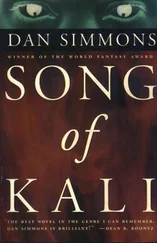“You remember,” I say to Jean-Claude, “that the Deacon’s friend we met at the Royal Geographical Society, the photographer and filmmaker John Noel, paid the Everest Committee eight thousand pounds for all cinema and still photo rights to last year’s expedition.”
“I remember because I thought it was an extraordinary amount of money,” says J.C.
I nod. “Well, Noel was sure he could make a profit if the expedition were successful last year, but he couldn’t really make a dramatic film showing Mallory’s and Irvine’s disappearance since there was only one photograph taken of them before they left Camp Four, and clouds got in the way of Noel’s long twenty-inch telephoto cinema lens, so Noel made one of the cinema releases more of a travelogue— The Roof of the World, he called it. The Deacon and I saw it in January before you returned from France.”
“So?”
“So there were things in the film—including a scene where an old man is finding fleas in a beggar child’s hair and then crushing them between his teeth—that the Tibetan government evidently objected to. Others objected to a bit where Mallory’s widow is quoted in titles as saying that she regretted the whole enterprise. But mostly the Tibetans have been objecting to the dancing lamas.”
“Dancing lamas?” repeats Jean-Claude. “Noel filmed them at Rongbuk Monastery?”
“Worse than that,” says Reggie. “John Noel paid a group of lamas to leave the Gyantse Monastery and to perform—live in cinemas in London and other British cities—what Noel in the film calls a ‘devil dance.’ The monks have turned into quite the performing troupe, some dancing while others play drums and blow on thigh-bone trumpets. It’s been very popular with English cinema-going audiences. Quite different from the usual fare. At the same time, the lamas were introduced as ‘holy men’ to the Archbishop of Canterbury. The uproar between Tibet and His Majesty’s Government has been ample enough for the Everest Committee to be turned down, by Tibet, for its proposed 1926 Everest expedition. It may be a decade or more before the British Alpine Club and Everest Committee receive another climbing permission.”
“Ahh,” says J.C. “I can see why the Tibetans feel humiliated. But how did the Tibetans learn what was happening in English cinema houses?”
Reggie smiles as the Deacon irritably repacks his pipe. “It isn’t really the Tibetans who are causing this moratorium on British expeditions to Everest,” she says. “It is Major Frederick Marshman Bailey.”
“Who the devil is Major Frederick Marshman Bailey?” I ask. This is the first I’ve heard of either the man’s name or the fact that it was he, not the Tibetans, who were throwing a spanner into the Everest Committee’s efforts to get a future climbing permission.
“He’s Political Officer for Sikkim,” says the Deacon from around his pipe stem. He sounds very angry. “Remember our maps? The easternmost province of the Raj in India, the one we have to trek through to get to Tibet? It’s a quasi-independent kingdom called Sikkim. Bailey got the Dalai Lama at Lhasa to back him on all this ‘the Tibetans are outraged’ nonsense, but in truth, it’s Bailey who’s stopping all British climbing permits except ours. He’s stopping German and Swiss permit attempts as well.”
“Why would he want to do that, Ree-shard? ” asks Jean-Claude. “I mean, I see why a British Political Officer would try to head off the Germans and Swiss, to keep Everest an English hill, but why on earth is he stopping permission for English expeditions?”
The Deacon seems too angry to speak. He nods to Lady Bromley-Montfort.
“Bailey is a former climber, having achieved some lower summits here in the Himalayas,” Reggie says. “He’s far past his prime—and he never got close to Mount Everest even in his prime—but many of us believe that he’s stirring up and exaggerating the Tibetan anger over the dancing lamas as a pretext to save the mountain for himself.”
I have to blink rapidly at this news. “Will he try this spring or summer?”
“He’ll never try,” says the Deacon through gritted teeth. “He just wants to spoil it for the others.”
“Then how did Lady…Reggie’s…request get approved by the Tibetan prime minister and the Dalai Lama at Lhasa?” asks Jean-Claude.
Reggie smiles again. “I went straight to the Dalai Lama and the prime minister for personal permission,” she says. “And ignored Bailey completely. He hates me for it. We shall have to transit Sikkim as quickly and quietly as we can, before Bailey finds some way to block us. He is a malevolent man. Our only advantage is that I’ve done several things by way of misdirection to make him believe that our expedition will be attempting transit to Chomolungma in August, post-monsoon, rather than now during the pre-monsoon months, and that we would be using the direct northern route—over Tangu Plain and up over the Serpo La—rather than the traditional route farther east.”
“Why would Bailey be so foolish as to believe that someone would attempt Everest in August again?” asks the Deacon. His 1921 recon expedition had done just that, only to find how deep the snow could be in August. But then again, it had been June 5 when Mallory, Somervell, and the others—minus the Deacon, who thought the snow conditions too dangerous—had lost seven Sherpas and Bhotias in an avalanche during Mallory’s stubborn attempt to return to Camp III on the North Col after heavy early monsoon snows.
“Because Pasang and six others and I did just that in August a year ago,” says Reggie.
All three of us turn to gaze at her in silence. Dr. Pasang’s presence is only half-registered in the flickering firelight as he stands behind the wingchair in which Reggie leans forward over her brandy. Finally, the Deacon says, “Did what?”
“Went to Everest,” Reggie replies, with an edge to her voice. “In an attempt to find Cousin Percy’s body. I would have gone earlier in the summer, but the monsoon was at its worst right after Colonel Norton, Geoffrey Bruce, and the others in Mallory’s former party beat their retreat back this way. Pasang and I had to wait until the worst of the rains—and the snows on Chomolungma—stopped before we trekked in with six Sherpas.”
“How far did you get?” says the Deacon, sounding dubious. “As far as Shekar Dzong? Further? Rongbuk Monastery?”
Reggie looks up from her brandy, and her ultramarine eyes seem much darker in her anger at the tone of the question. But her voice remains firm and under control. “Pasang and two of the other Sherpas and I spent eight days above twenty-three thousand feet at Mallory’s Camp Four. But the snow kept falling. Pasang and I did press on to Mallory’s Camp Five one day, but there were no supplies left there, and the storm grew worse. We were lucky to get back down to the North Col and were trapped there for four more of the eight days, with no food for the last three.”
“Mallory’s Camp Five was at twenty-five thousand two hundred feet,” Jean-Claude says in a very small voice.
Reggie only nods. “I lost more than thirty pounds during those eight days on the North Col at Camp Four. One of the Sherpas, Nawang Bura—you shall meet him tomorrow morning—almost died from altitude sickness and dehydration. We finally had a break in the weather on eighteen August, and we retreated all the way back to Mallory’s Camp One—the four Sherpas who’d remained at Camp Three below the Col all but carried Nawang down the glacier—where we regrouped before trekking out. The snows never stopped. The downpour continued as we clumped back through the steaming Sikkim jungles in mid-September. I thought I would never get dry.”
Читать дальше












